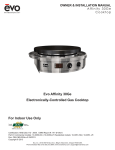Download FCUBS-FD04-02-01-Generic Interface Configuration Guide
Transcript
Oracle FLEXCUBE Universal Banking® 12.0 Generic Interface Configuration Guide Release 1.0 May 2012 Contents 1 Preface .......................................................................................................................................................... 3 Audience .................................................................................................................................................. 3 Related documents.................................................................................................................................... 3 Conventions ............................................................................................................................................. 3 2 Introduction .................................................................................................................................................. 3 2.1 How to use this Guide ............................................................................................................................... 3 3 Generic Interface – Getting started................................................................................................................. 4 4 Generic Interface Configuration overview...................................................................................................... 5 4.1 File Folders Creation ................................................................................................................................ 6 4.1.1 Outgoing ......................................................................................................................................... 6 4.1.2 Incoming ......................................................................................................................................... 6 4.2 Creation of External system ...................................................................................................................... 6 4.3 Creation of Interface definition ................................................................................................................. 9 4.3.1 Outgoing Interface........................................................................................................................... 9 4.3.2 Incoming ....................................................................................................................................... 17 4.4 Trigger Interface ..................................................................................................................................... 26 4.4.1 Outgoing ....................................................................................................................................... 26 4.4.2 Incoming ....................................................................................................................................... 27 4.5 Test results ............................................................................................................................................. 28 4.5.1 Outgoing ....................................................................................................................................... 28 4.5.2 Incoming ....................................................................................................................................... 29 1.1 1.2 1.3 FD04-02-01 Generic Interface Configuration Guide 2 1 Preface This document Generic Interface Configuration Guide explains the steps to create incoming or outgoing ASCII Generic Interface in FLEXCUBE UBS. 1.1 Audience This Generic Interface Configuration Guide is intended for FLEXCUBE Application Developers/Users who require to do the following tasks: Create Incoming ASCII upload interface using GI framework Create Outgoing ASCII handoff interface using GI framework 1.2 Related documents For more information on Interfaces, see these resources: FCUBS-FD01-01-01-Development Overview Guide FCUBS-FD04-01-01-Interface Getting started FCUBS-FD04-03-01-Upload Adapter Development Guide 1.3 Conventions The following text conventions are used in this document: Convention Meaning boldface Boldface type indicates graphical user interface elements (for example, menus and menu items, buttons, tabs, dialog controls), including options that you select. italic italic type indicates book titles, emphasis, or placeholder variables for which you supply particular values. moonscape Monospace type indicates language and syntax elements, directory and file names, URLs, text that appears on the screen, or text that you enter. 2 Introduction 2.1 How to use this Guide Chapter 2, “Introduction” This is an introduction section Chapter 3, “Getting Started” This section discusses GI Chapter 4, “Generic Interface Configuration Overview ” This section describes the GI functioning. FD04-02-01 Generic Interface Configuration Guide 3 3 Generic Interface – Getting started Generic Interface framework is used to define “Interface code” that acts as an entry point to upload data into FLEXCUBE UBS or handoff data from FLEXCUBE. There are two types of GI. Incoming – ASCII file data that needs to be uploaded into FLEXCUBE UBS Outgoing - FLEXCUBE UBS data to be created in ASCII file FD04-02-01 Generic Interface Configuration Guide 4 4 Generic Interface Configuration overview This section describes the overview of the Generic Interface Configuration. FD04-02-01 Generic Interface Configuration Guide 5 4.1 File Folders Creation Create following folder structure in the FLEXCUBE UBS Application server. 4.1.1 Outgoing Outgoing the file writing process takes place in the WIP folder and on successful completion of the writing process the file is moved to the Ready folder. The name of the file will be based on the File mask maintained in the Interface Definition 4.1.2 Incoming Incoming file should be placed in the ready folder when it is ready for upload. When the Interface is triggered, after successful file validation the file, the file is moved to the WIP folder and the Interface processing unit is triggered by the GI Processing framework. If the file validation fails the file is moved to the Error folder. On successful processing of the file the file is renamed based on the processed file mask attribute maintained in the interface definition and moved to the processed folder. 4.2 Creation of External system You need to maintain the details of the external system with which Oracle FLEXCUBE is interfacing using „External Interface Maintenance‟ screen. Function id for invoking the screen is „GWDEXSYS‟ External system maintenance FD04-02-01 Generic Interface Configuration Guide 6 Note: Refer GI.pdf FLEXCUBE UBS User manual for the meaning of each item in below screen FD04-02-01 Generic Interface Configuration Guide 7 Specifying File Transfer Protocol (FTP) Parameters Viewing External System Details You can view details of external Systems maintained in the system using „External System Summary‟ screen. You can invoke this screen by typing „GWSEXSYS’ . FD04-02-01 Generic Interface Configuration Guide 8 4.3 Creation of Interface definition 4.3.1 Outgoing Interface You can define the format details and properties associated with interface file in the „Interface Definition‟ screen. You can invoke this screen by typing „GIDIFTDF‟. FD04-02-01 Generic Interface Configuration Guide 9 Branch Code Specify the code of the branch to which the interface belongs. Here it is 000 Interface Type Select the interface type from the following options: • Incoming - Select this option if the file data needs to be uploaded into Oracle FLEXCUBE • Outgoing - Select this option if data from Oracle FLEXCUBE needs to be written into file. Here the interface type is Outgoing. File Mask Specify the file mask for the outgoing interface file. The name with which the file will be generated. External System Specify the external system with which Oracle FLEXCUBE is interfacing. Here the system is EXTGI the one created earlier. Format Type Select the type of data length in the interface from the following options: • Fixed – Select this option if the file data has to be in fixed width. • Delimited - Select this option if the file data has to be in delimited format. Delimiting Character field gets enabled for you to specify the delimiting character if you select the format type of definition as „Delimited‟. FD04-02-01 Generic Interface Configuration Guide 10 File Path Specify the path of the file. Example, gi/outgoing/data ( as mentioned in below picture) In case of GI Outgoing the file writing process takes place in the WIP folder and on successful completion of the writing process, the file is moved to the Ready folder. The name of the file will be based on the File mask maintained in the Interface Definition. Here it will be „OUT‟. Data Log Required Check this box to indicate if the confirmation details are required t in logged file. Commit/Fetch Frequency Specify the number of transaction committed or fetched at a given point of time. Date Format Specify the date format for the interface file. No of Executions Day If you select frequency type as „Daily‟, specify/select the number of interface file processing executions per day from the drop-down. This field is applicable only for incoming interface file process. Interface Code Specify a unique interface code to identify the interface as incoming or outgoing. Here the code is OUTER1 FD04-02-01 Generic Interface Configuration Guide 11 Delimiting Character Specify the delimiting character if you select the format type of definition as „Delimited‟. When to Run Select the stage of application the interface has to be triggered. Mandatory Check this box to indicate that the interface has to be mandatorily processed before moving on to the next stage of EOD. If this box is checked system checks if the interface has been processed or not and if it is not processed system will not allow movement to the next EOD stage. Triggering Select an appropriate option to indicate how the interface should be triggered. The options available are: • Manual – Select this option if the interface has to be triggered manually. • System – Select this option if the interface has to be triggered automatically. During EOD if there are any mandatory unprocessed interfaces and if the triggering type is selected as „System‟ then the interface is triggered automatically. In case of Incoming interface if triggering type is selected as „System‟ then system checks if the file is available in the „ready‟ folder for that interface. If the file is present the system will process it. In case of outgoing interface if triggering type is selected as „System‟ then, system will automatically trigger the Outgoing interface. Here its manual type. It can be triggered manually whenever required. Frequency Type Select the frequency type for interface file processing from the following drop-down options: • Daily • Weekly • Fort Nightly • Monthly • Quarterly • Yearly • Adhoc Week Day If you select frequency type as „Weekly‟, select the day from the drop-down list for processing the interface file. The options available are: • Sunday • Monday • Tuesday • Wednesday • Thursday • Friday • Saturday FD04-02-01 Generic Interface Configuration Guide 12 Month If you select frequency type as „Fort Nightly, Monthly, Weekly, Yearly‟, select the month for the interface files execution from the drop-down list. The options available are: January-December If you select frequency type as „Fort Nightly, Monthly, Weekly, Yearly‟, select the date of the month for the interface file execution from the drop-down list. Last Run Date The last run date gets displayed here Next Run Date The day on which the interface can be triggered gets displayed here. Padding Character You can specify the padding character of fixed length format type interface file here. All the data types can have the same padding character Date Select the padding character for date field from the drop-down. Number Select the padding character for number field from the drop-down. Text Select the padding character for text field from the drop-down. Pre Message Specify the value that should be calculated before triggering the interface in the predefined format. Post Message Specify the value that should be calculated after Interface processing is done in the predefined format. Pre Message AUDF Specify the AUDF that needs to be invoked before triggering the interface. You can use this to add additional functionality required at the message level. Post Message AUDF Specify the AUDF that needs to be invoked after triggering the interface. You can use this to add additional functionality required at the message level. Specifying Component Details FD04-02-01 Generic Interface Configuration Guide 13 You can specify the component details here. Click „Component Details‟ button in the „Interface Definition‟ screen. Component Linkage You can specify the component linkage details here. Serial Number Specify the component position here. Component Name Specify a name for the component. Here the name is BDY. Component Type This field indicates the component type of the file, following are the possible values of component type. Header Body Footer FD04-02-01 Generic Interface Configuration Guide 14 Batch Header Batch Footer Batch Body Here the type is BODY. Parent Specify the parent component to which component is linked Relation If parent component is specified, then specify the relation here. Batch by Field Specify the field in the component based on which you want to create a batch. This is applicable only for Outgoing Interfaces. Where Clause Specify the where Clause for the component Post Component Group By Specify the group by clause for the component. Order By Specify the order by clause for the component. Pre Component Specify the value to be calculated before the component is processed, if any. Pre Component AUDF Specify the AUDF that has to be executed before the component is processed, if any. You can use this to add any additional functionality required at the component level. Specify the value to be calculated after the Component is processed, if any. Post Component AUDF Specify the AUDF that has to be executed after the component is processed, if any. You can use this to add any additional functionality required at the component level Pre Record Specify the value that needs to be calculated before the record is processed, if any. Pre Record AUDF Specify the AUDF that has to be executed before the record is processed, if any. You can use this to add any additional functionality required at the record level. Post Record Specify the value that needs to be calculated after the record is processed, if any. FD04-02-01 Generic Interface Configuration Guide 15 Post Record AUDF Specify the AUDF that has to be executed after the record is processed, if any. You can use this to add any additional functionality required at the record level. Component Field Linkage You can specify the component field linkage details here i.e the data to be fetched in the file. Serial Number Specify the order of fields here. Field Name Specify the field name here, that will be created for the interface. Field Type Select the type of field from the options available in the drop-down list. The options available are • Message • Intermediate • Start Identifier • End Identifier • Action Default Specify the default value for the field here. Data type Specify the data type of the field here. Length Specify the length of the field here. Column Name Specify the column name in the database of the field here. From the data source. Object Name Specify the object name from which the field should be derived. Name of the table for which data is to be written in the flat file. Here the table name is “JKTM_JUNK_TRNCODE” Start Position Specify the start index of the field in the fixed length format. Precision If the field is of numeric type, then specify precision here. Translation If the field value needs to be translated then select the translation code that has to be used for the translation. FD04-02-01 Generic Interface Configuration Guide 16 Un-translated Specify the action to be taken if the translation value is not present Derivation Specify the derivation logic for the field. Pre Field Specify the value that needs to be calculated before the field value is processed. Pre Field AUDF Specify the AUDF that should be executed before the processing of the field here. Post Field Specify the value that needs to be calculated after the field value is processed. Post Field AUDF Specify the AUDF that should be executed after the processing of the field. 4.3.2 Incoming Branch Code FD04-02-01 Generic Interface Configuration Guide 17 Specify the code of the branch to which the interface belongs. Here it is 000 Interface Type Select the interface type from the following options: • Incoming - Select this option if the file data needs to be uploaded into Oracle FLEXCUBE • Outgoing - Select this option if data from Oracle FLEXCUBE needs to be written into file. Here the interface type is INCOMING. File Mask Specify the file mask for the outgoing interface file. External System Specify the external system with which Oracle FLEXCUBE is interfacing. Here the system is EXTGI the one created earlier. Format Type Select the type of data length in the interface from the following options: • Fixed – Select this option if the file data has to be in fixed width. • Delimited - Select this option if the file data has to be in delimited format. Delimiting Character field gets enabled for you to specify the delimiting character if you select the format type of definition as „Delimited‟. File Path Specify the path of the file. Example, gi/incoming/data ( as mentioned in below picture) In case of GI Incoming the Incoming file should be placed in the ready folder when it is ready for upload. When the Interface is triggered, after successful file validation the file, the FD04-02-01 Generic Interface Configuration Guide 18 file is moved to the WIP folder and the Interface processing unit it triggered by the GI Processing framework. If the file validation fails the file is moved to the Error folder. On successful processing of the file the file is renamed based on the processed file mask attribute maintained in the interface definition and moved to the processed folder. Data Log Required Check this box to indicate if the confirmation details are required t in logged file. Commit/Fetch Frequency Specify the number of transaction committed or fetched at a given point of time. Date Format Specify the date format for the interface file. No of Executions Day If you select frequency type as „Daily‟, specify/select the number of interface file processing executions per day from the drop-down. This field is applicable only for incoming interface file process. Interface Code Specify a unique interface code to identify the interface as incoming or outgoing. Here the code is INCOME Delimiting Character Specify the delimiting character if you select the format type of definition as „Delimited‟. When to Run Select the stage of application the interface has to be triggered. Mandatory Check this box to indicate that the interface has to be mandatorily processed before moving on to the next stage of EOD. If this box is checked system checks if the interface has been processed or not and if it is not processed system will not allow movement to the next EOD stage. Triggering Select an appropriate option to indicate how the interface should be triggered. The options available are: • Manual – Select this option if the interface has to be triggered manually. • System – Select this option if the interface has to be triggered automatically. During EOD if there are any mandatory unprocessed interfaces and if the triggering type is selected as „System‟ then the interface is triggered automatically. In case of Incoming interface if triggering type is selected as „System‟ then system checks if the file is available in the „ready‟ folder for that interface. If the file is present the system will process it. In case of outgoing interface if triggering type is selected as „System‟ then, system will automatically trigger the Outgoing interface. FD04-02-01 Generic Interface Configuration Guide 19 Here its manual type. It can be triggered manually whenever required. Frequency Type Select the frequency type for interface file processing from the following drop-down options: • Daily • Weekly • Fort Nightly • Monthly • Quarterly • Yearly • Adhoc Week Day If you select frequency type as „Weekly‟, select the day from the drop-down list for processing the interface file. The options available are: • Sunday • Monday • Tuesday • Wednesday • Thursday • Friday • Saturday Month If you select frequency type as „Fort Nightly, Monthly, Weekly, Yearly‟, select the month for the interface file execution from the drop-down list. The options available are: January-December If you select frequency type as „Fort Nightly, Monthly, Weekly, Yearly‟, select the date of the month for the interface file execution from the drop-down list. Last Run Date The last run date gets displayed here Next Run Date The day on which the interface can be triggered gets displayed here. Padding Character You can specify the padding character of fixed length format type interface file here. All the data types can have the same padding character Date Select the padding character for date field from the drop-down. Number Select the padding character for number field from the drop-down. FD04-02-01 Generic Interface Configuration Guide 20 Text Select the padding character for text field from the drop-down. Pre Message Specify the value that should be calculated before triggering the interface in the predefined format. Specify the value that should be calculated after Interface processing is done in the predefined format. Pre Message AUDF Specify the AUDF that needs to be invoked before triggering the interface. You can use this to Post Message add additional functionality required at the message level. Post Message AUDF Specify the AUDF that needs to be invoked after triggering the interface. You can use this to add additional functionality required at the message level. Incoming File You can specify the interface details applicable for incoming file details here. Function ID Specify the function id for which the incoming data need to be sent. Here the function id is JKDTRNCD Processed File Mask Specify the file mask for renaming the incoming file after uploading the data. Default Action Select the default action which needs to be invoked to process the uploaded data in the upload table from the drop-down list below: • New • Modify • Close Here the action is NEW On Override Select the action to be taken if an override occurs from the drop-down list below: • Reject • Continue • Skip Outgoing Interface Specify the corresponding outgoing interface file for the above incoming file. FD04-02-01 Generic Interface Configuration Guide 21 Specifying Component Details You can specify the component details here. Click „Component Details‟ button in the „Interface Definition‟ screen. Component Linkage You can specify the component linkage details here. Serial Number Specify the component position here. Component Name Specify a name for the component. Here the name is BDY. Component Type This field indicates the component type of the file, following are the possible values of component type. Header Body FD04-02-01 Generic Interface Configuration Guide 22 Footer Batch Header Batch Footer Batch Body Here the type is BODY. Parent Specify the parent component to which component is linked Relation If parent component is specified, then specify the relation here. Batch by Field Specify the field in the component based on which you want to create a batch. This is applicable only for Outgoing Interfaces. Where Clause Specify the where Clause for the component Group By Specify the group by clause for the component. Order By Specify the order by clause for the component. Pre Component Specify the value to be calculated before the component is processed, if any. Pre Component AUDF Specify the AUDF that has to be executed before the component is processed, if any. You can use this to add any additional functionality required at the component level. Post Component Specify the value to be calculated after the Component is processed, if any. Post Component AUDF You can use this to add any additional functionality required at the component level Specify the AUDF that has to be executed after the component is processed, if any. Pre Record Specify the value that needs to be calculated before the record is processed, if any. Pre Record AUDF Specify the AUDF that has to be executed before the record is processed, if any. You can use this to add any additional functionality required at the record level. Post Record FD04-02-01 Generic Interface Configuration Guide 23 Specify the value that needs to be calculated after the record is processed, if any. Post Record AUDF Specify the AUDF that has to be executed after the record is processed, if any. You can use this to add any additional functionality required at the record level. Component Field Linkage You can specify the component field linkage details here i.e the data to be fetched in the file. Serial Number Specify the order of fields here. Field Name Specify the field name here, that will be created for the interface. Field Type Select the type of field from the options available in the drop-down list. The options available are • Message • Intermediate • Start Identifier • End Identifier • Action Default Specify the default value for the field here. Data type Specify the data type of the field here. Length Specify the length of the field here. Column Name Specify the column name in the database of the field here. From the data source. Object Name Specify the object name from which the field should be derived. Name of the table for which data is to be written in the flat file. Here the table name is “JKTM_JUNK_TRNCODE” Start Position Specify the start index of the field in the fixed length format. Precision If the field is of numeric type, then specify precision here. Translation FD04-02-01 Generic Interface Configuration Guide 24 If the field value needs to be translated then select the translation code that has to be used for the translation. Un-translated Specify the action to be taken if the translation value is not present Derivation Specify the derivation logic for the field. Pre Field Specify the value that needs to be calculated before the field value is processed. Pre Field AUDF Specify the AUDF that should be executed before the processing of the field here. Post Field Specify the value that needs to be calculated after the field value is processed. Post Field AUDF Specify the AUDF that should be executed after the processing of the field. Specifying Incoming File Names Click on „Incoming File Names‟ button in the „Interface Definition‟ screen to specify the incoming interface file names. FD04-02-01 Generic Interface Configuration Guide 25 File Names The incoming file names are maintained here. File Name Specify the incoming interface file name here. 4.4 Trigger Interface You can trigger the process of Generic Interface using Gateway Messages, EOD run or through „Interface Trigger‟ screen. You can invoke this screen by typing „GIDIFPRS’ 4.4.1 Outgoing You can provide the following details here to invoke the GI routing package. Branch Code Specify the branch code from where the GI file process has to be initiated. Interface Code Select the Interface Code that has to be processed. External System Specify the external system from/to where the details have to be picked up or delivered respectively. Here the external system is EXTGI Interface Type Select the type of interface from the drop-down list. The options available are: FD04-02-01 Generic Interface Configuration Guide 26 • Incoming • Outgoing Here it‟s O i.e. Outgoing File Name Specify the file name if the selected Interface Code is Incoming. Process Code Select the process code from the drop-down list, if the selected Interface Code is Incoming. The options available are: • FP - Populating the Upload tables using the file data. • DP- Populating the Base tables from the Upload tables. • AL-This is will trigger „FP‟ and „DP‟ processes one after another. • RT-This is Retry operation the previous process that failed is triggered. • RE-This will rerun the „DP‟ process for error records. For an outgoing file it is a single process of reading for database and writing in to file. But for incoming file there are two steps, 1. Reading the data from file and inserting into upload table - File Process (FP) 2. Reading the data from upload table and uploading as part of base table - Data Process (DP) Now the file is generated in the path as mentioned in the interface definition. 4.4.2 Incoming FD04-02-01 Generic Interface Configuration Guide 27 Branch Code Specify the branch code from where the GI file process has to be initiated. Interface Code Select the Interface Code that has to be processed. External System Specify the external system from/to where the details have to be picked up or delivered respectively. Here the external system is EXTGI Interface Type Select the type of interface from the drop-down list. The options available are: • Incoming • Outgoing Here its I i.e. Incoming File Name Specify the file name if the selected Interface Code is Incoming. Process Code Select the process code from the drop-down list, if the selected Interface Code is Incoming. The options available are: • FP - Populating the Upload tables using the file data. • DP- Populating the Base tables from the Upload tables. • AL-This is will trigger „FP‟ and „DP‟ processes one after another. • RT-This is Retry operation the previous process that failed is triggered. • RE-This will rerun the „DP‟ process for error records. For an outgoing file it is a single process of reading for database and writing in to file. But for incoming file there are two steps, 1. Reading the data from file and inserting into upload table - File Process (FP) 2. Reading the data from upload table and uploading as part of base table - Data Process (DP) It‟s Process All so that it will first initiate the FP and then DP. If successfully the process is triggered it will update the data in the file to the table as defined in the interface details.(i.e. data from in.txt to JKTM_JUNK_TRNCODE) 4.5 Test results 4.5.1 Outgoing In the specified path location check for the outgoing file generated with the name specified in the interface definition screen. FD04-02-01 Generic Interface Configuration Guide 28 4.5.2 Incoming Ensure the upload table is populated with records from incoming file FD04-02-01 Generic Interface Configuration Guide 29 Generic Interface Configuration Guide May 2012 1.0 Oracle Corporation World Headquarters 500 Oracle Parkway Redwood Shores, CA 94065 U.S.A. Worldwide Inquiries: Phone: +1.650.506.7000 Fax: +1.650.506.7200 www.oracle.com/ financial_services/ Copyright © 2012 Oracle Financial Services Software Limited. All rights reserved. No part of this work may be reproduced, stored in a retrieval system, adopted or transmitted in any form or by any means, electronic, mechanical, photographic, graphic, optic recording or otherwise, translated in any language or computer language, without the prior written permission of Oracle Financial Services Software Limited. Due care has been taken to make this document FD04-02-01 Generic Interface Configuration Guide and accompanying software package as accurate as possible. However, Oracle Financial Services Software Limited makes no representation or warranties with respect to the contents hereof and shall not be responsible for any loss or damage caused to the user by the direct or indirect use of this FD04-02-01 Generic Interface Configuration Guide and the accompanying Software System. Furthermore, Oracle Financial Services Software Limited reserves the right to alter, modify or otherwise change in any manner the content hereof, without obligation of Oracle Financial Services Software Limited to notify any person of such revision or changes. All company and product names are trademarks of the respective companies with which they are associated. FD04-02-01 Generic Interface Configuration Guide 30















































